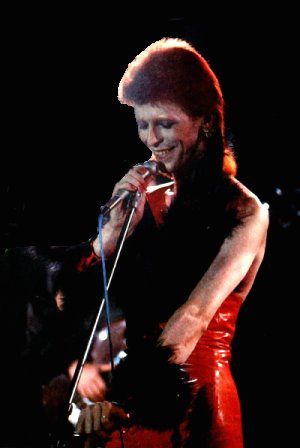BOWIE 1980 Floor Show at the Marquee Club, London.




Recorded: 18, 19 & 20 October 1973
Broadcast: 16 November 1973 (US Only)
Venue: The Marquee Club, 90 Wardour Street, Soho, London & television studios.
Producer & director: Stan Harris
Musicians: David Bowie, Mick Ronson, Trevor Bolder, Mike Garson (piano),
Mark Carr Pritchard (guitar) & Aynsley Dunbar (drums)
The Astronettes (Geoffrey MacCormack, Jason Guess & Ava Cherry): backing vocals
Rocco Urbisci: creative consultant
Jaques Andre: associate producer
Matt Mattox: choreography
Freddi Burretti: costumes
Barbara Daley: make-up
Natasha Korniloff: Amanda Lear's costume in "Sorrow"
Billy The Kid: Hair
George Underwood: Graphics
Ken Scott & Ground Control (Robin Mayhew): Sound Mix
The 1980 Floor Show (a pun on the song "1984" - 19-Eighty-Floor) was the first appearance of David Bowie since his much publicised retirement on 3 July 1973 at the Hammersmith Odeon. It was also to be his last appearance as "Ziggy Stardust". The show itself was a spectacular stage production that was filmed over 3 days, mostly at The Marquee Club, Soho, London for the American NBC TV late night show The Midnight Special.
The idea for the show came when Bowie was approached by Burt Sugarman to create something for The Midnight Special rock series. Bowie's idea was a highly theatrical cabaret extravaganza featuring himself and various rock groups from the 60's performing in a futuristic setting. Michael Lipman, a Los Angeles lawyer specializing in the music industry, set up the deal in which Bowie was to have complete artistic control. When news of the forthcoming event became public, the UK newspapers cried that the Americans had netted the "pop scoop of the year" and bemoaned the fact that no clips were to be made available for UK TV.

The result was edited down to fit the one-hour rock series slot and was shown on American NBC-TV on 16 November 1973. Apart from segments for Top of the Pops it has never been fully screened in the UK. While still regularly screened on US TV, the show is unfortunately still not available commercially in any form.
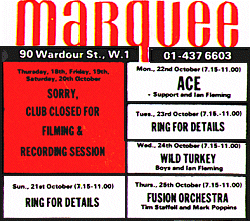
The first day of the 1980 Floor Show was reserved for filming at a studio - while the actual filming at the Marquee was carried out on the 19th & 20th October. Bowie personally chose the setting for the show, after first considering the possibility of a full-scale live concert (rejected by the NBC as too expensive).
"There were a lot of clubs to go to in the Soho scene in the 60's but The Marquee was top of the list, because musicians did hang out there, pretending to talk business and picking up gigs - but picking up girls mostly. One of my keenest memories of The Marquee in the '60's was having a permanent erection because there were so many fantastic looking girls in there, it was all tourists, especially in summer, all flocking to London to get an R&B star. My final performance of Ziggy Stardust was at The Marquee. I wanted to go back there because I had so many good memories over the years. We changed the place completely and for 3 days we filmed what became 'The 1980 Floor Show'. I had The Troggs on with me and then got Marianne Faithfull to duet with me on a version of Sonny & Cher's 'I Got You Babe'. I dressed Marianne in a nun's habit with the back cut out and I dressed as the Angel of Death!" - Bowie
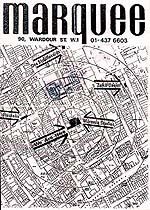
The Marquee's October 1973 programme
The mysterious listing for 18-20 Oct showed no artist name and instead read:
"LUCKY FOR SOME....UNLUCKY FOR MANY! On Thurs, Fri & Sat 18th, 19th & 20th October NBC T.V. have taken the Marquee for FILMING & LIVE Recordings of some Very Special Artistes. There will be a very few tickets available for each of the evenings...Details will be posted within the Club."
Admission to the show was by invitation only and those who attended included 200 democratically selected (by ballot) members of the newly formed International David Bowie Fan Club, rock luminaries, staff and patrons of The Marquee and selected musical press - all keen on seeing Ziggy rise from the grave to perform one last time. Included in this exclusive audience were Angie and Zowie, Tony Visconti and Mary Hopkins, Lionel Bart, Dana Gillespie, Long John Baldry and Wayne County.
The show also featured Marianne Faithfull, The Troggs and a Spanish vocal group called Carmen. This was to be the last time that Mick Ronson and Trevor Bolder played with Bowie as Spiders.
Bowie's performance on Saturday the 19th October, went on for 10 hours as each song was performed and filmed over and over. Because of the small size of the Marquee, only two cameras were able to film and so each song was shot, as many as five to six times, to allow for camera re-positioning and the overall satisfaction of Bowie and the film crew. The whole thing was, according to Bowie later, "shot abysmally." The fans, of course, loved the fact that they got to see their hero perform many times over. During the intervals between takes, and despite having just recovered from a recent bout of influenza, Bowie laughed and joked with the audience and signed autographs.

The songs performed were:
![]() 1984/Dodo (Bowie)
1984/Dodo (Bowie)
![]() Sorrow (Bowie)
Sorrow (Bowie)
![]() Bulerias (Carmen)
Bulerias (Carmen)
![]() Everything's Alright (Bowie)
Everything's Alright (Bowie)
![]() Space Oddity (Bowie)
Space Oddity (Bowie)
![]() I Can't Explain (Bowie)
I Can't Explain (Bowie)
![]() As Tears Go By (Marianne Faithfull)
As Tears Go By (Marianne Faithfull)
![]() Time1 (Bowie)
Time1 (Bowie)
![]() Wild Thing (The Troggs)
Wild Thing (The Troggs)
![]() The Jean Genie (Bowie)
The Jean Genie (Bowie)
![]() Rock n Roll Suicide (Bowie) - not broadcast
Rock n Roll Suicide (Bowie) - not broadcast
![]() 20th Century Blues (Marianne Faithfull)
20th Century Blues (Marianne Faithfull)
![]() I Got You Babe (Bowie/Marianne Faithfull)
I Got You Babe (Bowie/Marianne Faithfull)
Prior to the filming of the very first number, Bowie strode on stage, beamed at the audience and said in a broad South London accent "And what have you lot been up to?" and told them that he was "out of condition".
The first song to be filmed was "Everything's Alright" from the Pinups (1973) album. Bowies costume for this number was bright yellow trousers, a purple satin top, black leather jacket and high-heeled boots. All of the costumes for the show were designed by Bowie and old friend Freddie Burretti.
Mick Ronson's costume for the show was an all white satin jump-suit. Ronson led the band of Trevor Bolder, Aynsley Dunbar, Mike Garson and Mark Carr Prichard (introduced by Bowie as "Mark Two Rivers, a Mohician from Peage"!). Interestingly, Aynsley Dunbar, the drummer, was originally from The Mojos who had written "Everything's Alright" in the 1960s. A smiling Bowie ended each song with an affectionate pat on Ronson's back. This was to be the last time that Bowie and Ronson were to be on the same stage until they were reunited in Canada in 1983 during the Serious Moonlight Tour.
The Astronettes (not to be confused with the same named dancers at the Rainbow Concert) were Bowie's backing vocals and dance group for the show and consisted of Geoffrey MacCormack, Jason Guess & Ava Cherry.

For "The Jean Genie" - Bowie's fish net and gold hands-costume was altered twice by the film crew. First a gold dummy hand with black varnished nails which covered his private parts was removed, as was a revealing black jockstrap and were covered with a gold briefs and arm slip (as above). The NBC were concerned that the suggestively placed dummy hand would be too shocking for American audiences. The film crew were subsequently instructed to film above Bowie's waist for that number. Other censorship for US TV occurred later when words such as "screw" and "goddam" were edited from the soundtrack.
"I did one particular song, can't remember what it was now but I had a strange kind of string knitted costume made with three hands on. Two of them on my chest, looking like I was being gripped from the back...And a third one on my crotch. I nearly started a riot with the Americans. They said: "Oh we can't show that, that's subversive." We went through hell, so I had to take the hand of my crotch. And then of course they didn't like the black pouch piece that was down there, that the hand was stitched to...so I had to change all that. So, like the 'Diamond Dogs' thing that they airbrushed the dick off, I was having more erasure problems. It followed me all through the Seventies.* It's funny that I can remember the costume and not the song, totally indicative of what the time was like." - Bowie (2002)
During "Rock N Roll Suicide" the word "suicide" was bleeped each time it appeared in the song. This was because earlier that year a boy had died in the US trying to imitate part of Alice Coopers stage act where he was hung onstage. Subsequently it was dropped from the final edit by NBC.
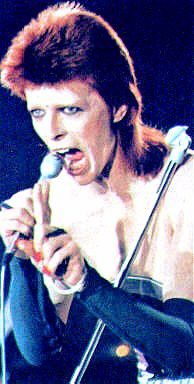
For "1984" - Bowie wore a Ziggy cloak which was stripped away by Ava Cherry and Jason Guess to reveal the "keyhole costume."
"Sorrow" was filmed in the studio with Bowie dressed in a white suit singing to Amanda Lear, who with a pole manipulated string-costumed figures on a giant chessboard.
For "I Can't Explain" - Bowie wore a bright red PVC corset, PVC thigh-length stiletto boots and two black chest-hugging feathers and smaller feathers on his wrists (he was The Angel of Death).
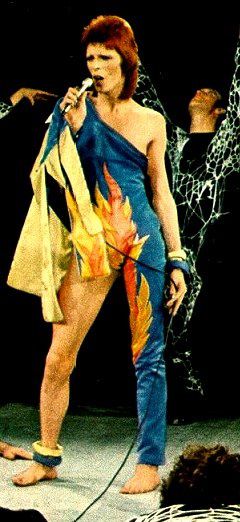
For "Time" (The backing track for this song was from Aladdin Sane (1973)) Bowie wore a blue and yellow flaming design half-leotard with cloak as above. The live version of the song at this show is included on RARESTONEBOWIE (1995) and is notable for the (forced?) lyric change (...falls swanking to the floor...).

The last song - "I Got You Babe" was a duet sung with Marianne Faithful and was filmed at about 10pm at night. Bowie warned the audience - "This isn't anything very serious. Its just a bit of fun - we've hardly even rehearsed it." Bowie's costume for this song was the bright red PVC corset, PVC thigh-length stiletto boots and two black chest-hugging feathers (he was The Angel of Death), while Marianne Faithful was dressed as a decadent nun with cowl and a black backless cape, which left her bottom exposed to the audience as she quickly ran off stage at the end of the performance.
"She was wearing a nun's habit with no backside and black stockings. I've got that clip at home, and it is fantastic. But they wouldn't show it in America. It was felt to be beyond the pale. Madonna, eat your heart out!" - Bowie (1993)
About Marianne: Married and a mother at 18 years of age, Faithfull took up with Mick Jagger at 19, endured the Stones' very public Redlands drug bust at 20 (she was arrested wearing nothing but a bearskin rug), and attempted suicide at 21. At 22, Faithfull saw her first original song, "Sister Morphine," yanked off the shelves after two days (the Stones released their version two years later without any fuss). Ironically, Faithfull had used heroin only once before writing the song; by the time it came out, she was a hopeless junkie, her own ambitions overwhelmed by the Rolling Stones juggernaut. The inevitable break-up with Jagger was followed by a decade of disaster in which Faithfull became a junkie living on the streets, her self-destructive behaviour almost preordained: She was the great-niece of Leopold von Sacher-Masoch, author of the late 19th-century novel "Venus in Furs," the source of the term "masochism." But by the mid-'70s, there was the glimmer of a rehabbed image via David Bowie, who sought out Faithfull as a '60s archetype for the 1974 television special tied to the release of his covers album, "Pin Ups." It started the singer on the road to recovery. A few years later, punk revitalised Faithfull -- not so much the music, but the angry attitude, and 1979's "Broken English" unveiled a very different artist, whose once-high, plaintive soprano had slid down a whole octave into dark, husky, cracked contralto with seemingly bottomless vibrato. It was an astonishing resurrection, and 10 years after the disappointment of "Sister Morphine," Faithfull was, for the first time, a respected artist. By Richard Harrington - Washington Post Staff Writer (2002).
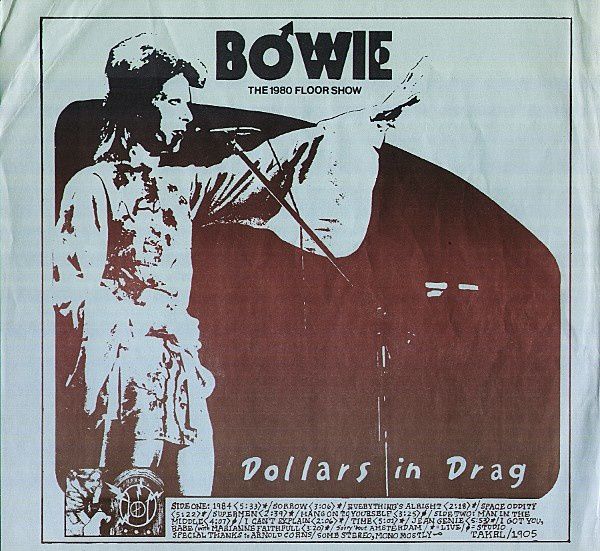
1980 Floor Show bootleg LP "Dollars in Drag"
Thanks to The Ziggy Stardust Companion / 5Years.com
Outtakes from the Floorshow, filmed in October 1973 at the Marquee Club, London. With Marianne Faithful.
" I can't explain " & " I got you, babe "
Voici un trésor ... les répètes du Floor show filmé en octobre 1973 au club Marquee de Londres.
On y voit une bonne soeur nue sous sa robe ... c'est Marianne Faithfull. Mick Ronson, le guitar hero, frise l'arrêt cardiaque ...
ATTENTION: moment d'anthologie !

